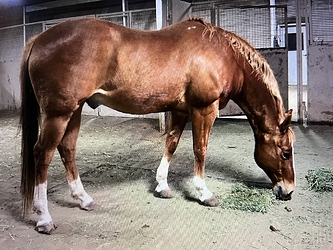Small Update:
I put him on the longe yesterday. He tripped 6 times; 5 to the left (all ‘small’) trips, and once to the right (bigger, but not a fall). The times he fell/almost fell were going right. All the trips happened in the first half of the longe session.
I used a surcingle with side reins that approximated my usual hand position and rein length, and I attempted to get him to work under himself and carry himself as I do under saddle. He did not trip with the side reins OFF, but I did not work him as hard and his frame was longer/looser, with his hind end trailing behind him. I warmed up and cooled down without side reins.
In the trot, the trips are as though he unloads the foot that is down before the stride has completed…then falls forward onto the foot that’s about to take his weight. I think this suggests a hind end soreness. I also didn’t love how he looked behind, but I’m also one of those people who sees lameness everywhere when I look for it.
He also has essentially no gaskin muscle; which could be for any number of reasons, and may or may not be related. He’s got a lot of loft/spring, but getting him to move UNDER himself instead of out behind has always been a struggle, he tries, but overcoming his natural way of going is hard.
While I mentioned he has always been a little trippy, I really noticed it starting 2 summers ago, and I wonder if he has had issues for a while now, but his increased workload and weight this year are negatively impacting him more than usual. Until the last few weeks, he’s always come out happy to work and putting in tons of effort.
At this point, I’m going to discuss doing the following tests:
EPM
Lyme
Cushings
And am going to start with a lameness exam and discuss if this could be a vertebral issue in the neck.
The vet also suggested trimming and doing an equioxx trial and see where that gets us before her visit. So I’ll do that with light longing to evaluate.
Still very open to thoughts and suggestions. I have a few more days to mull over this, gather information, and make a pre-plan before the vet comes out.

